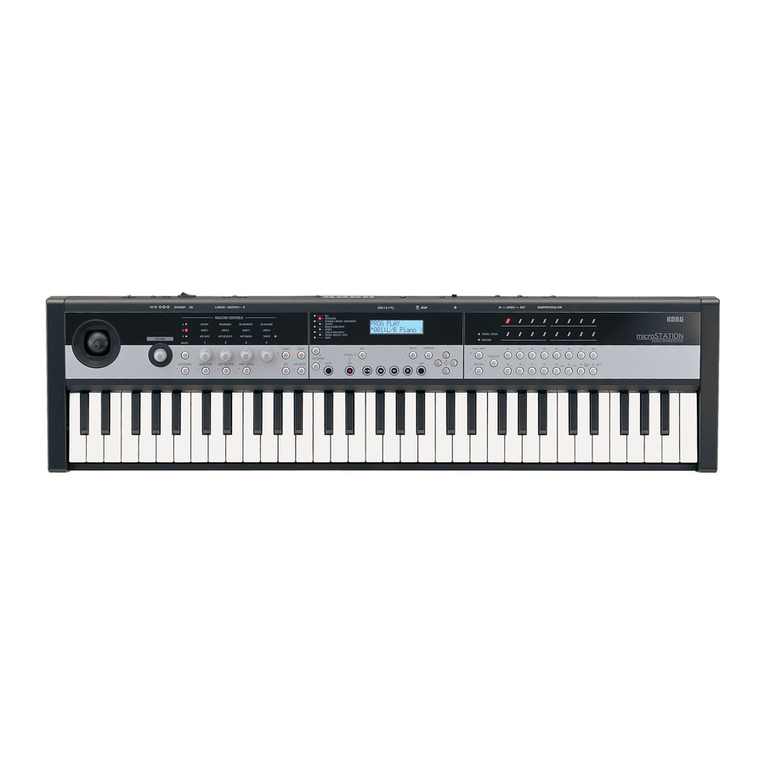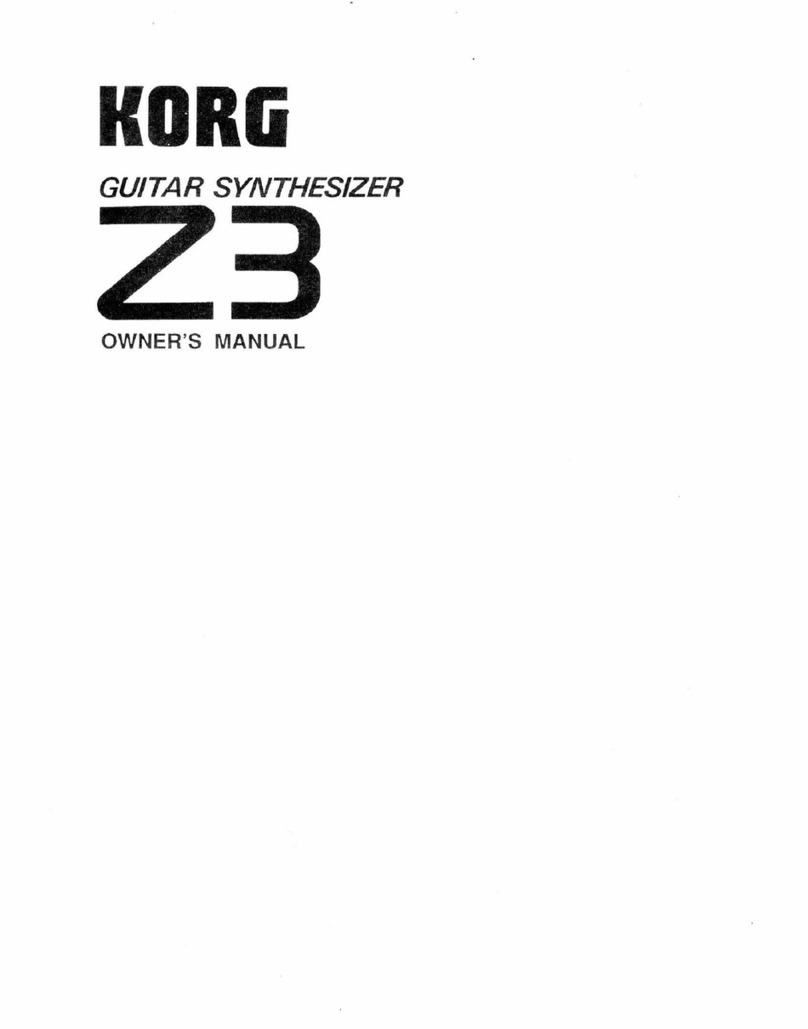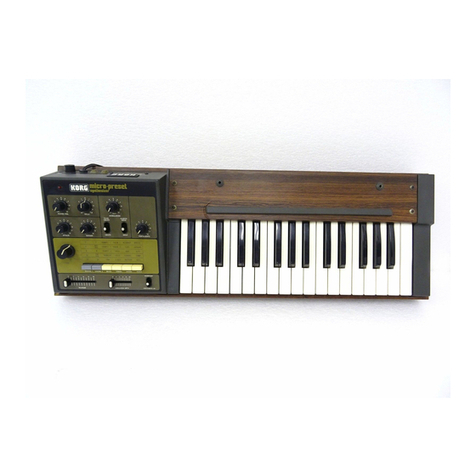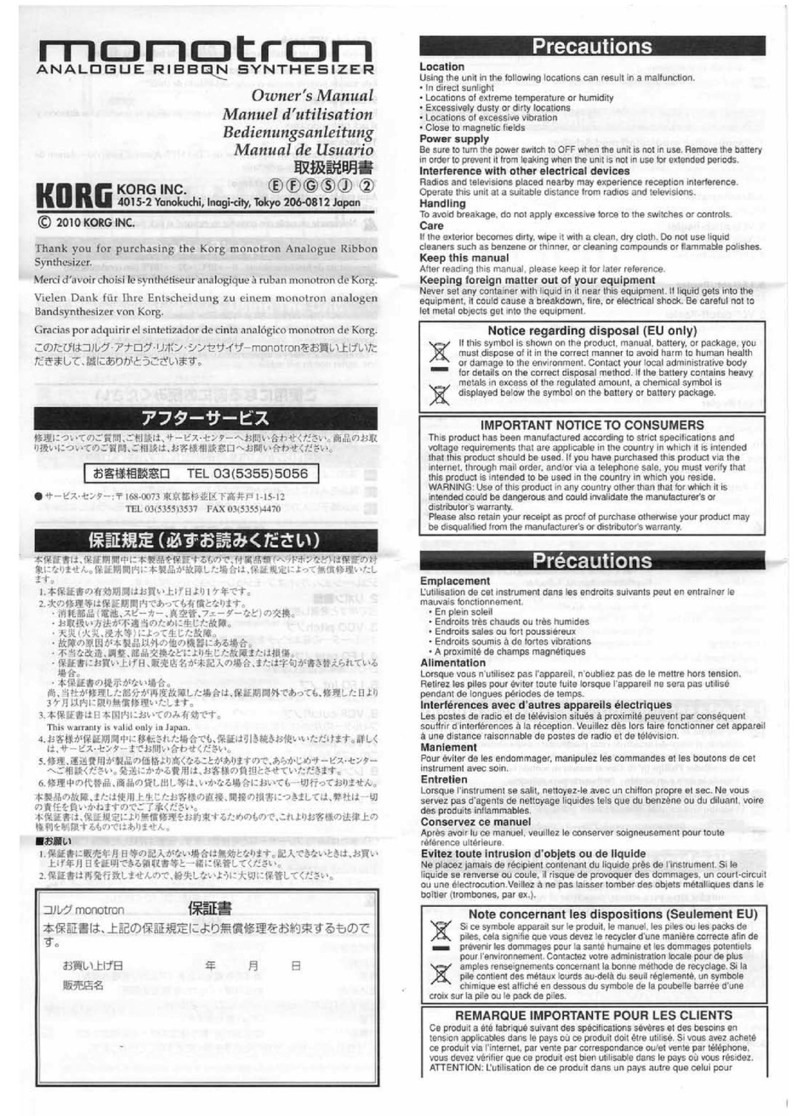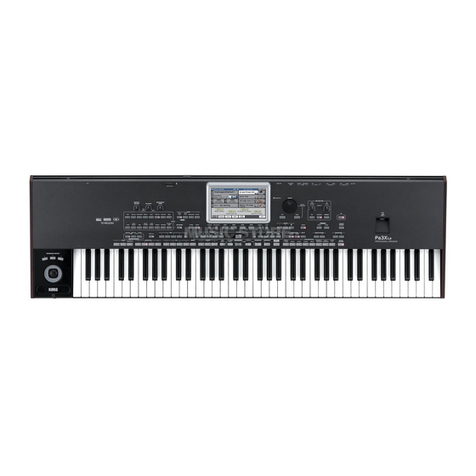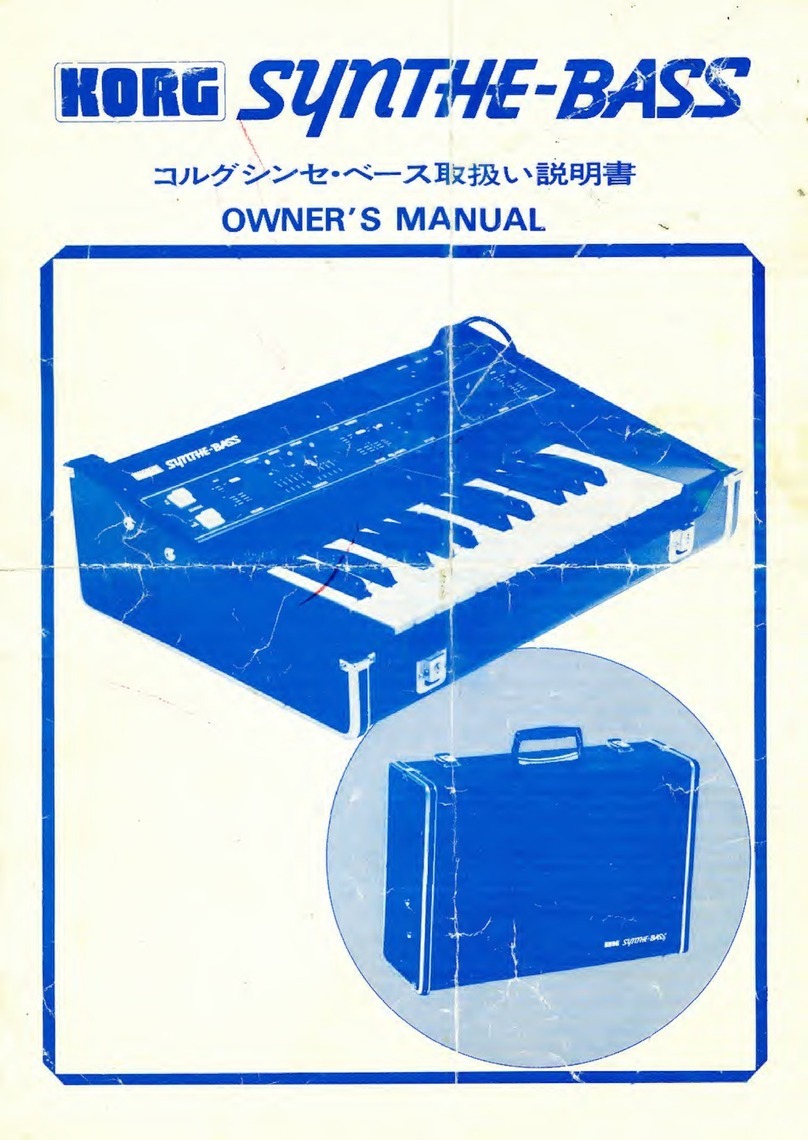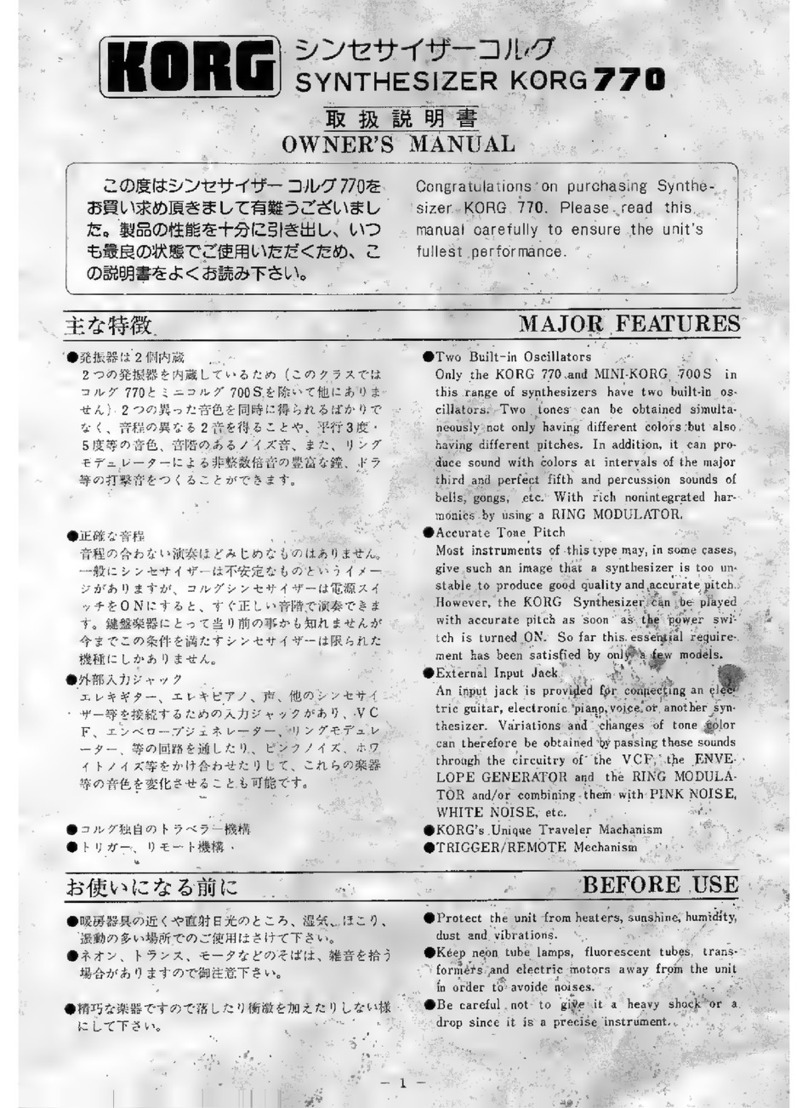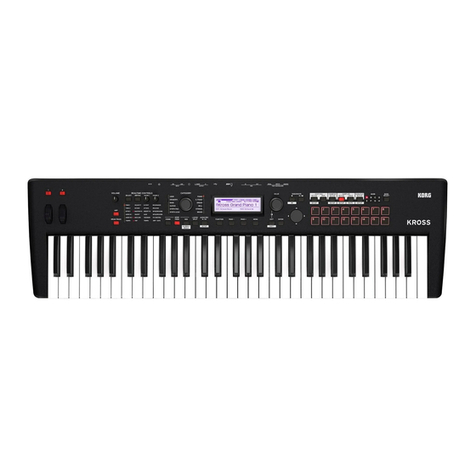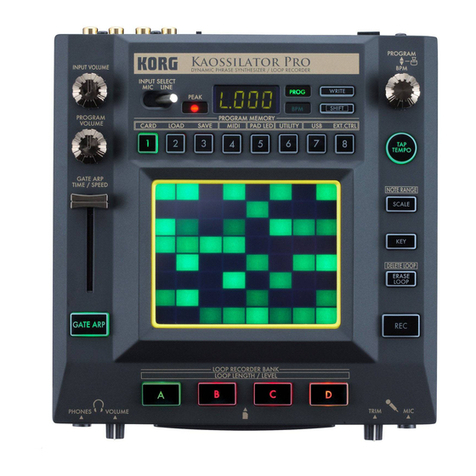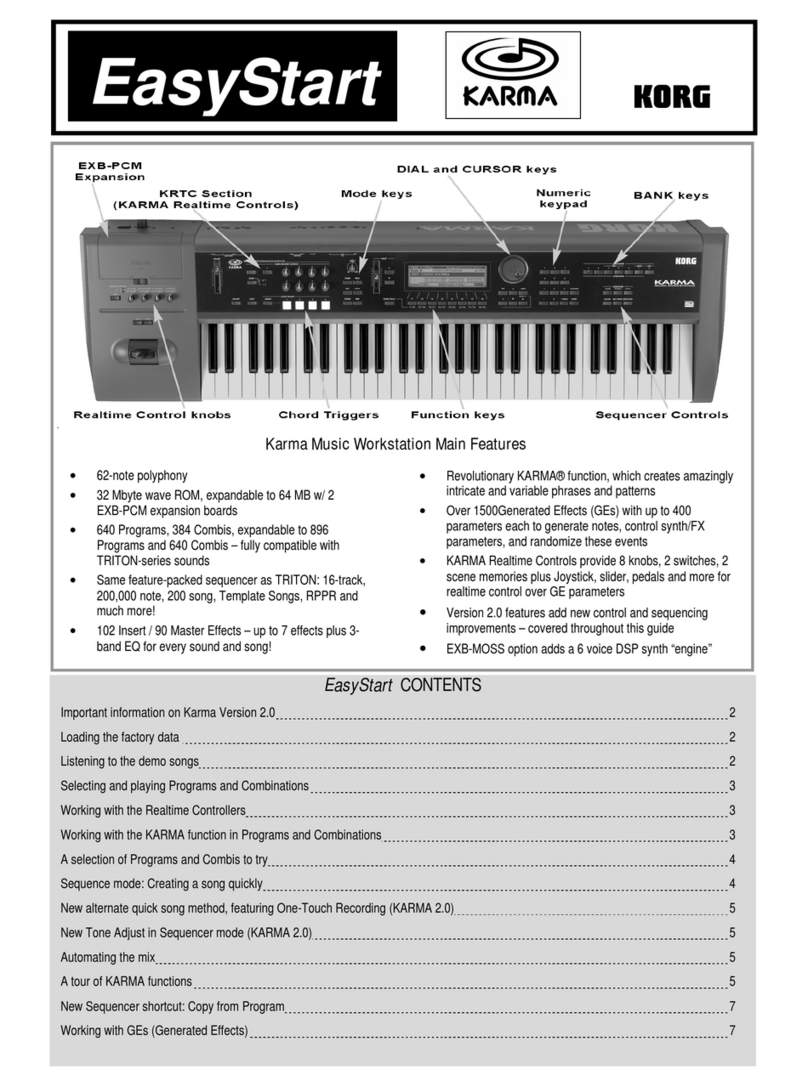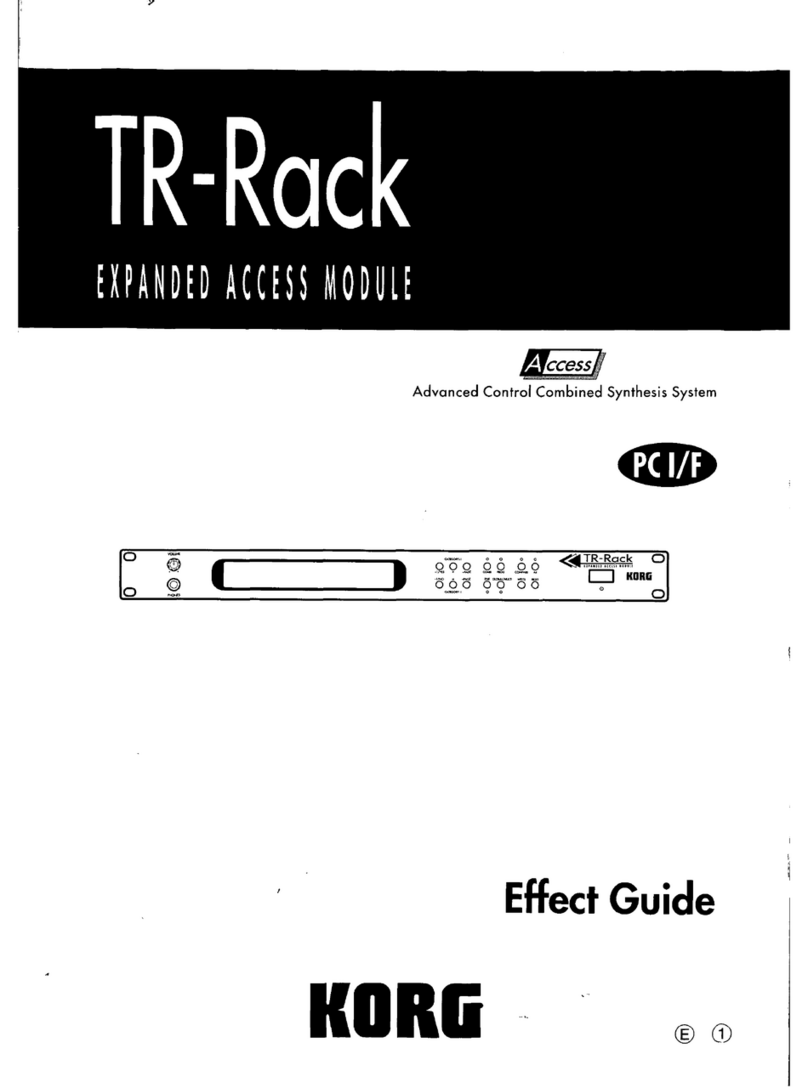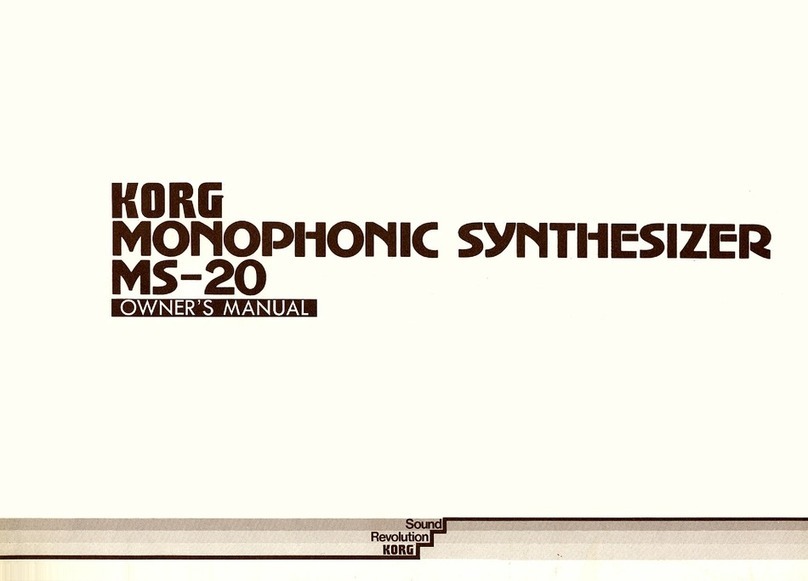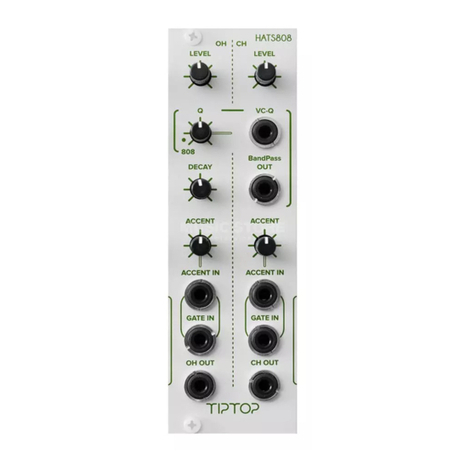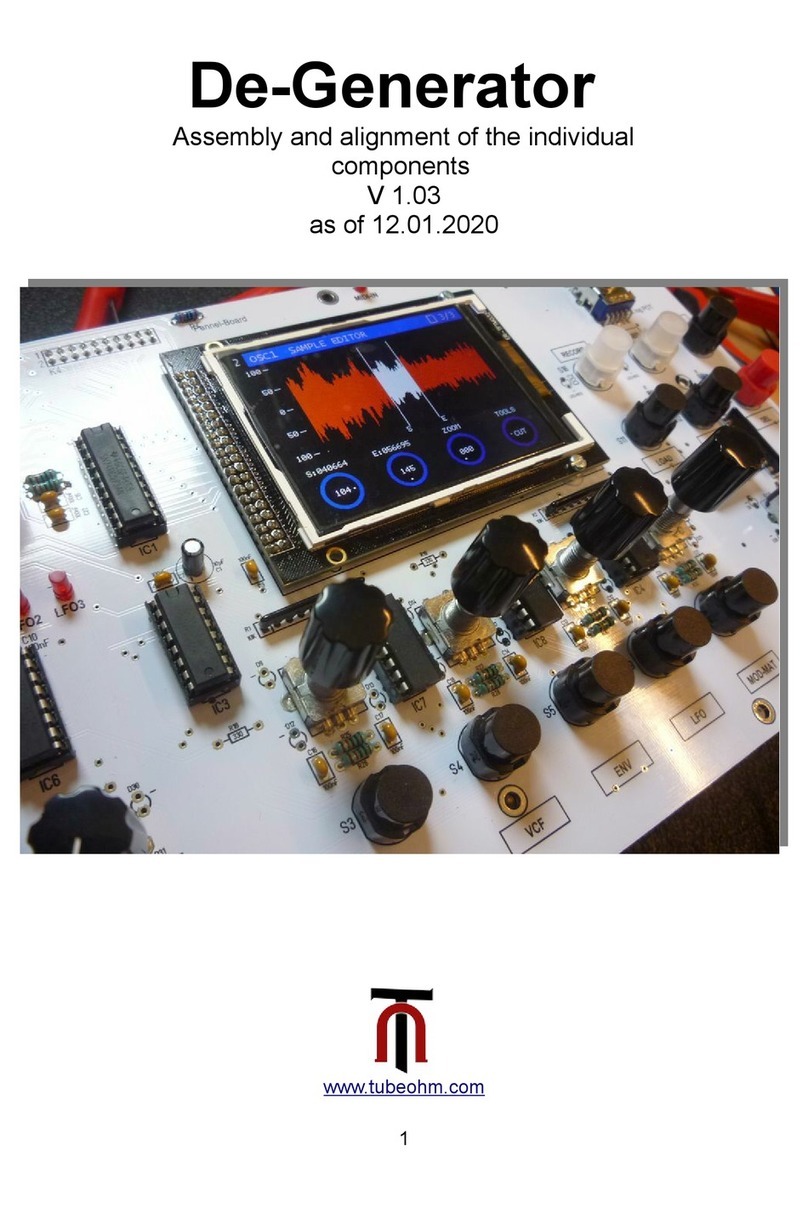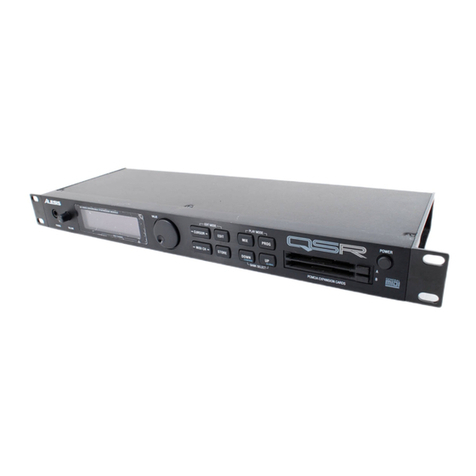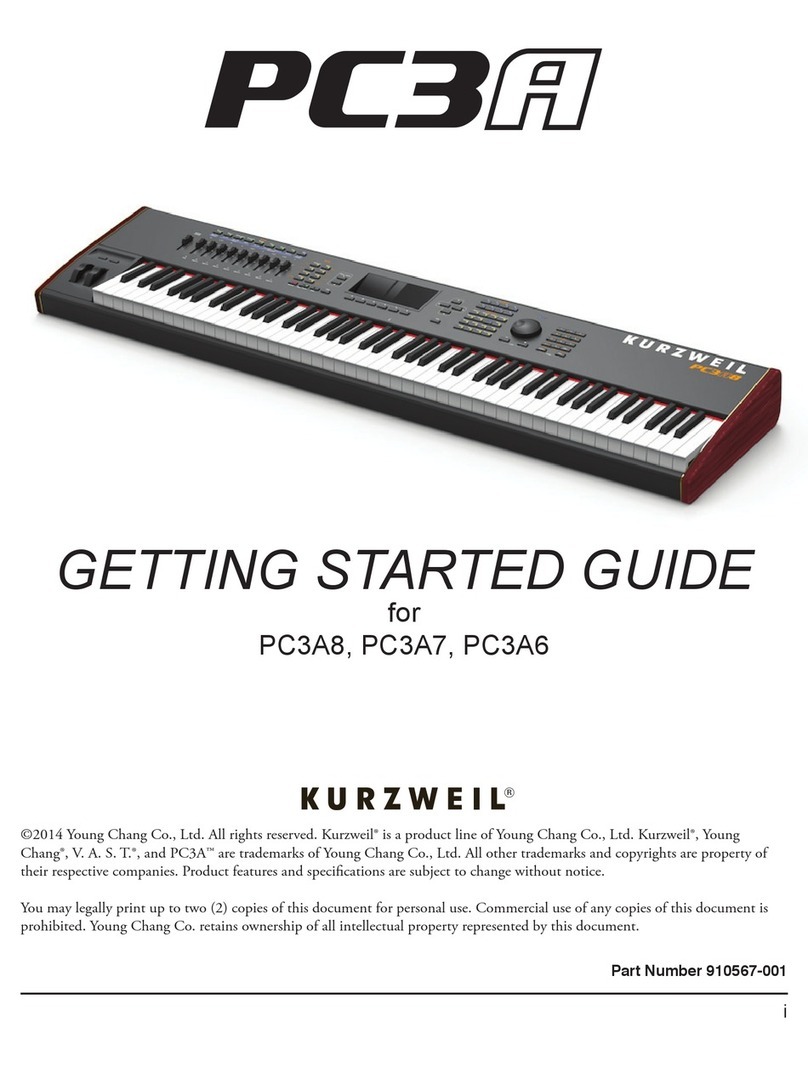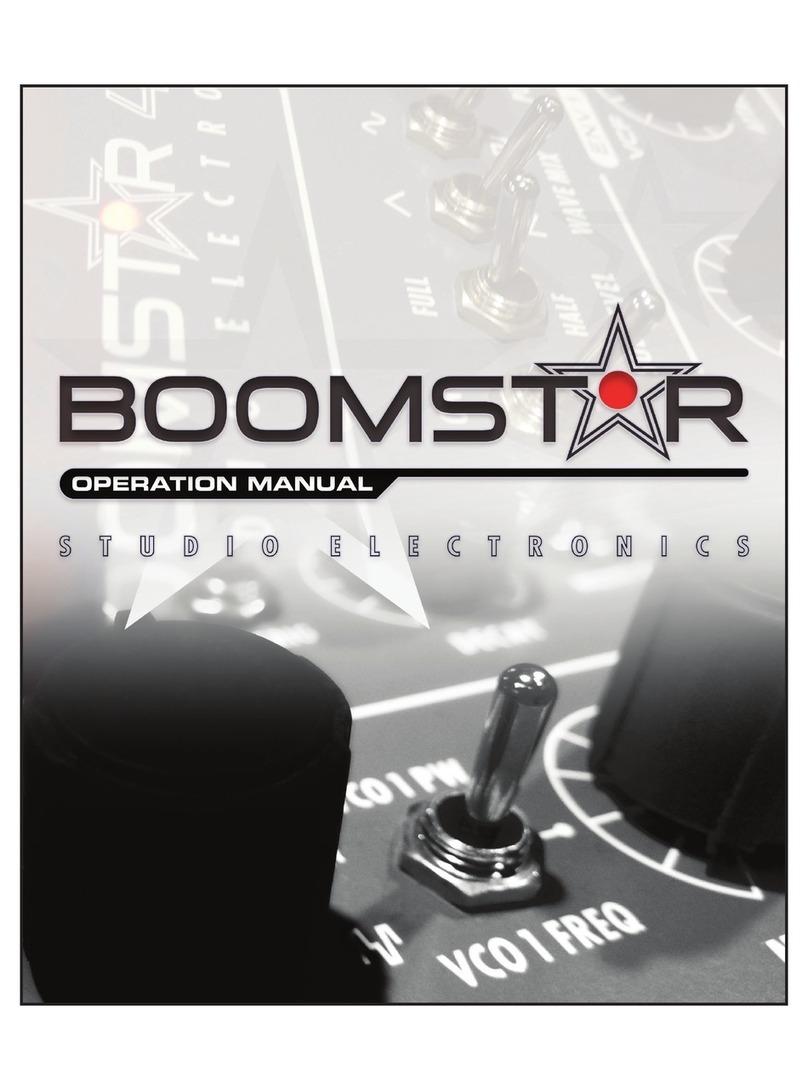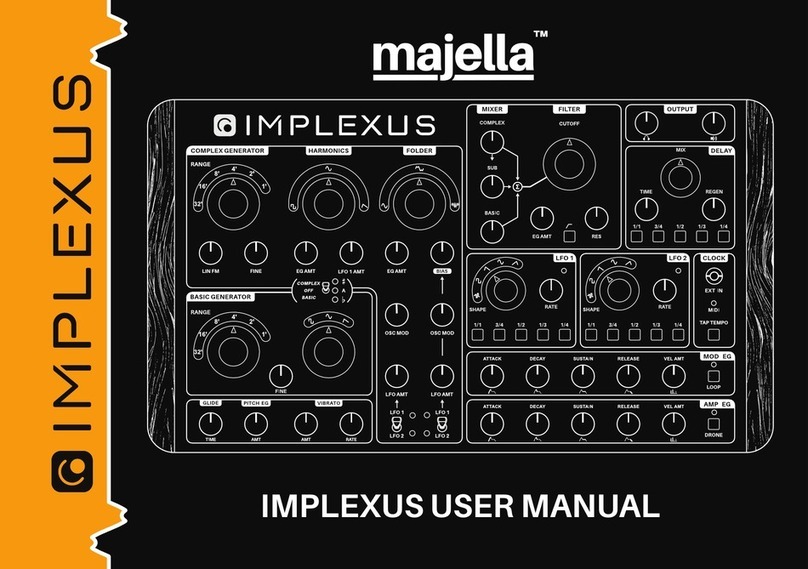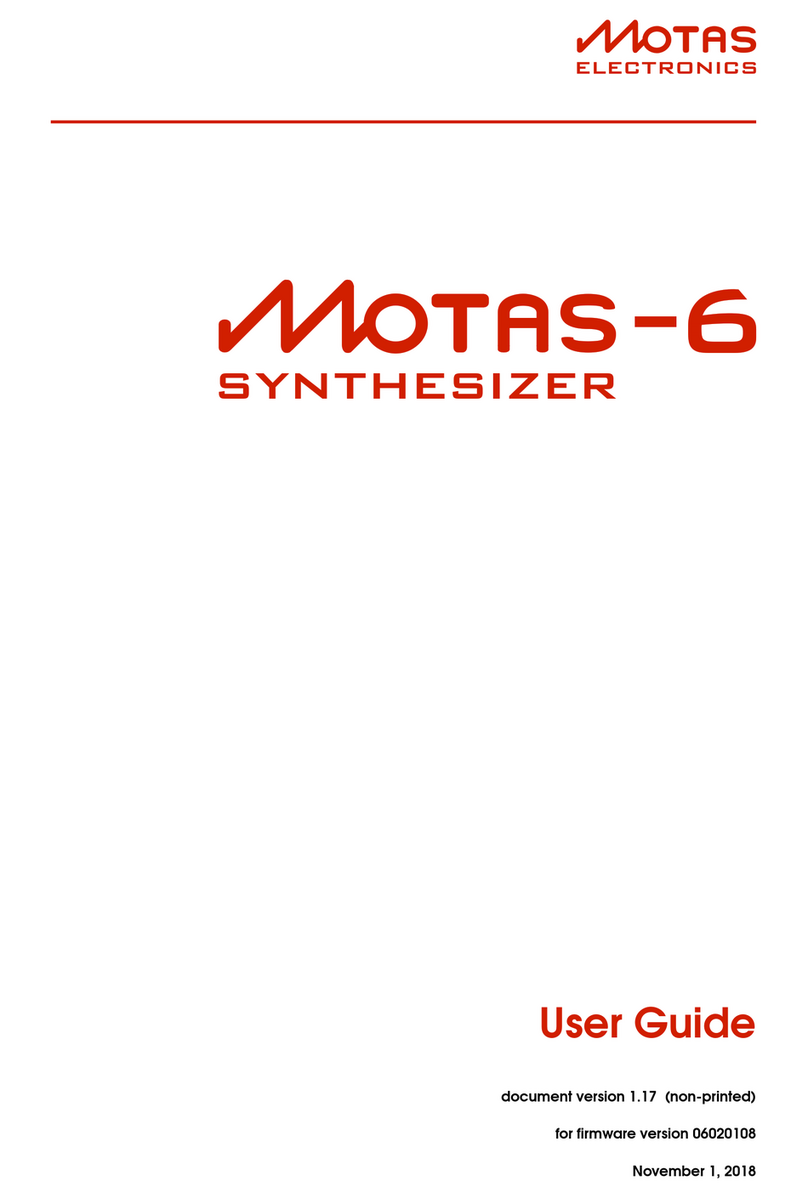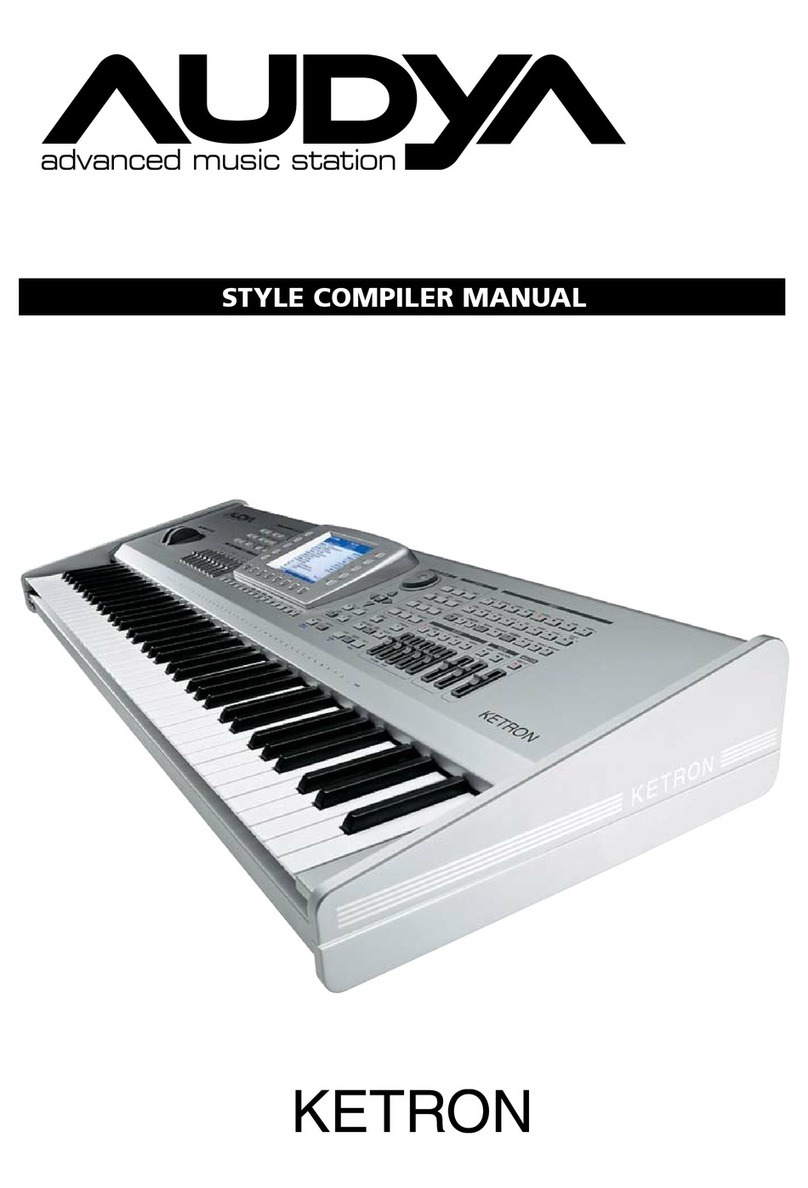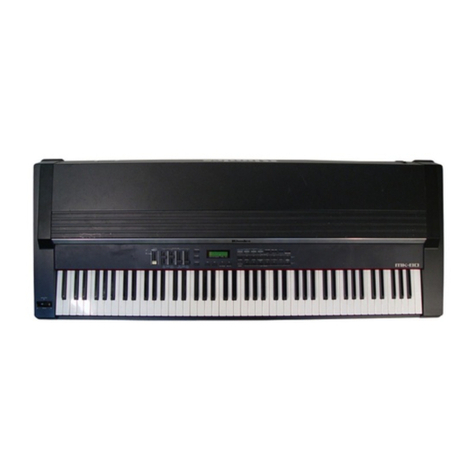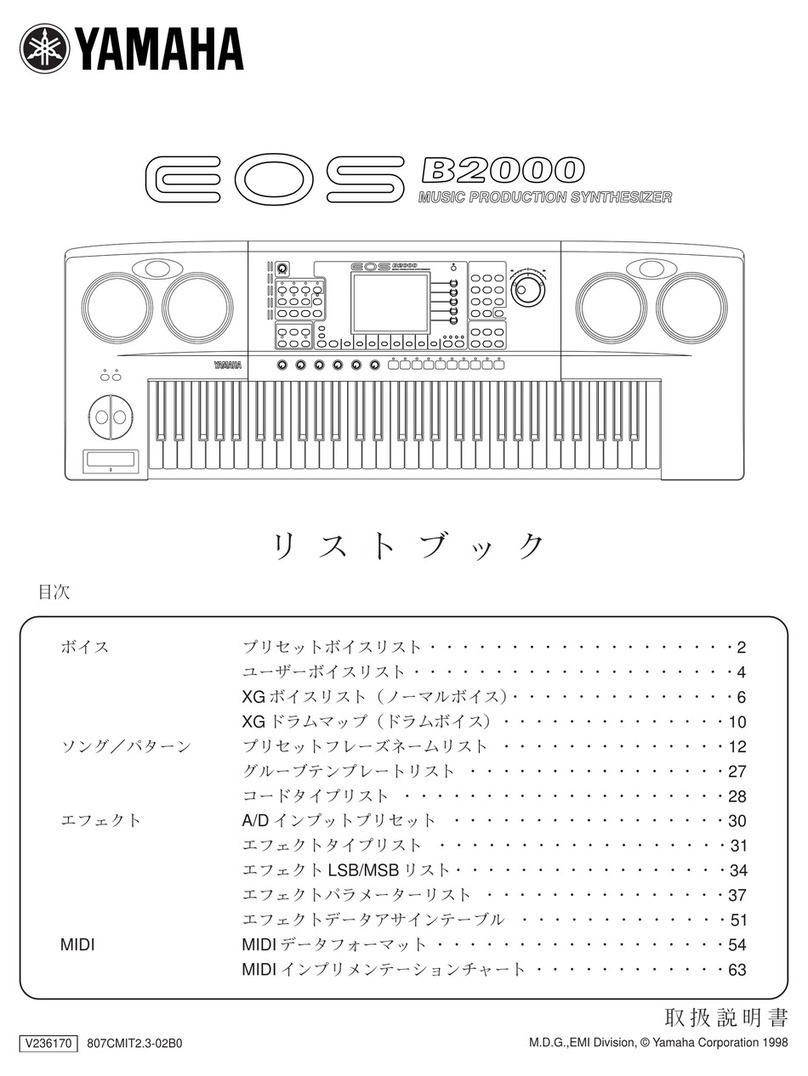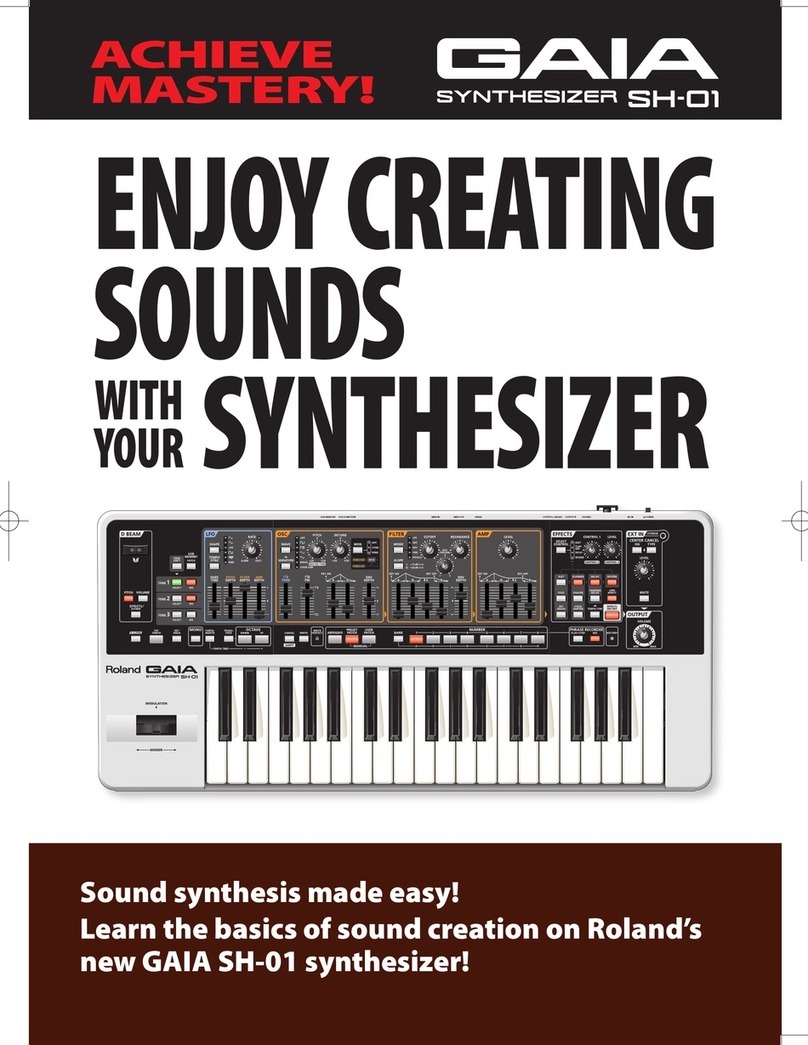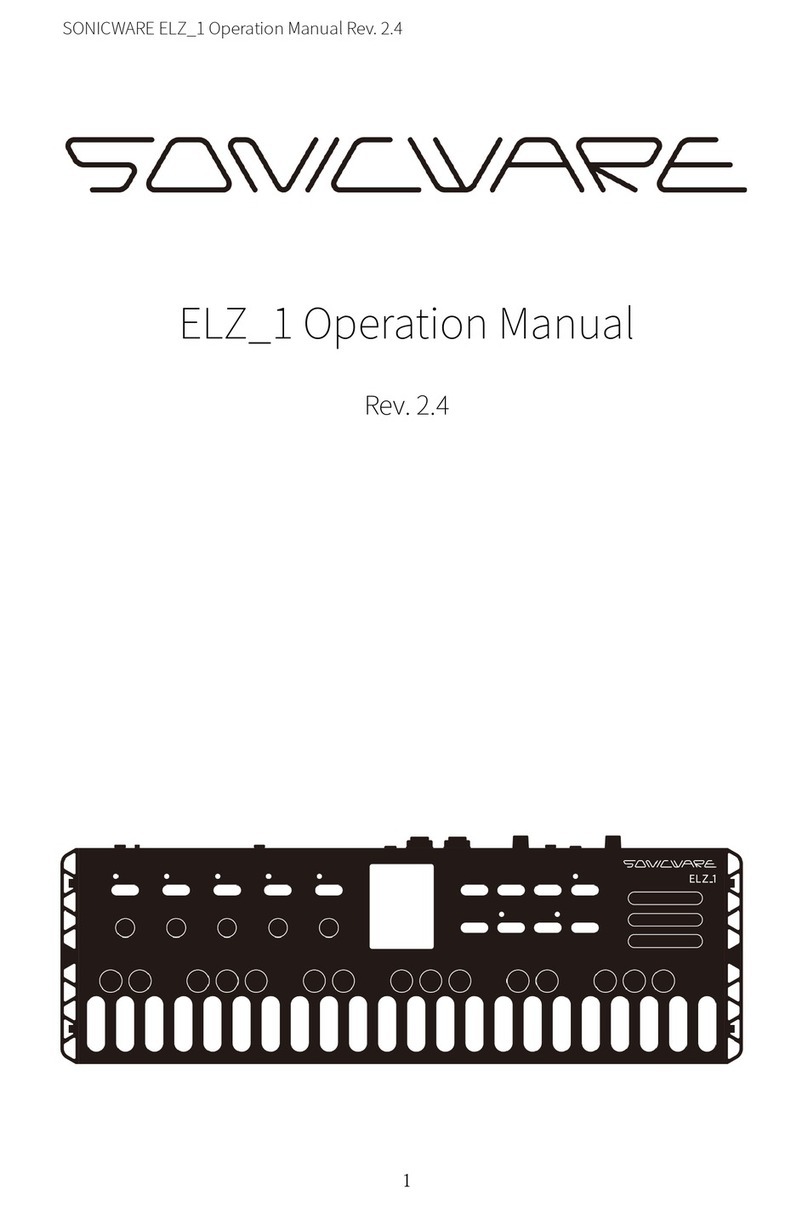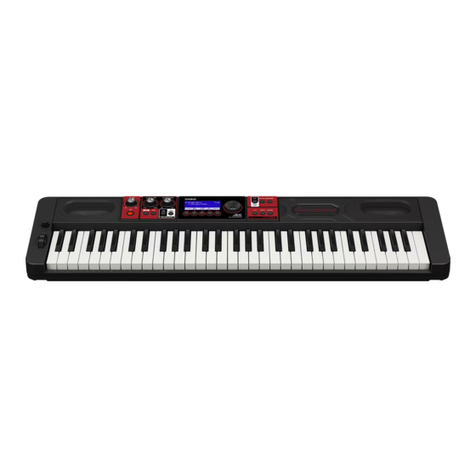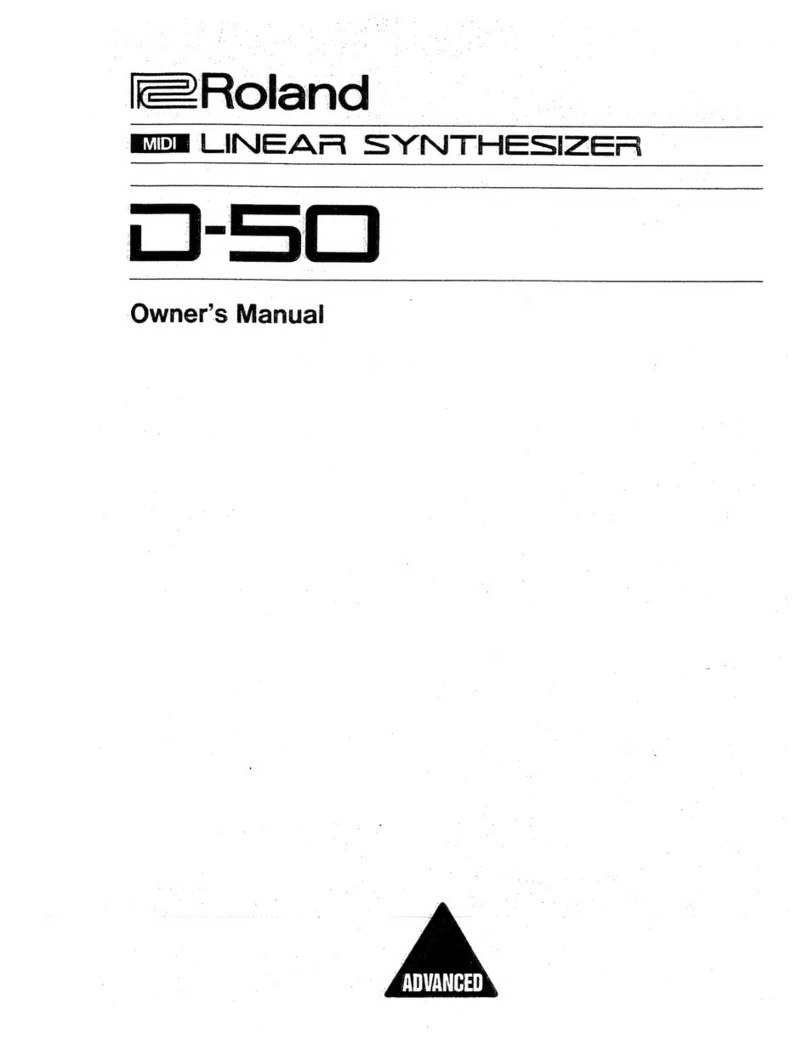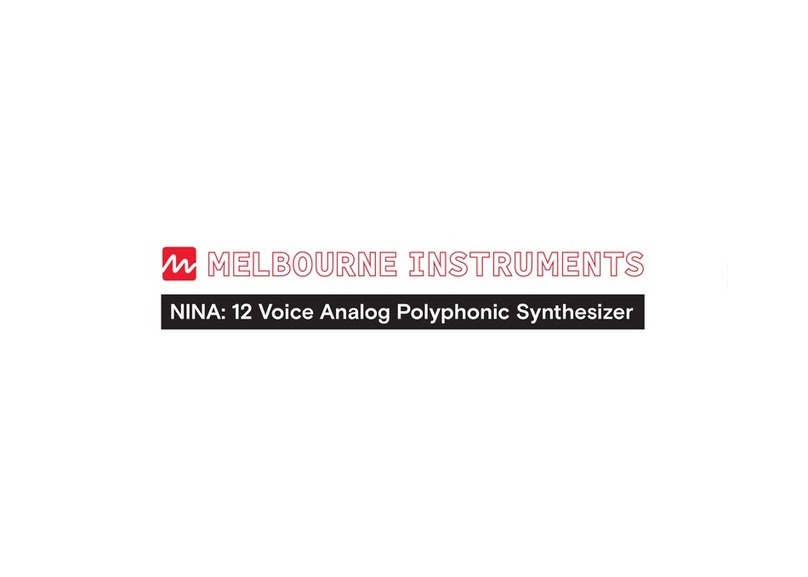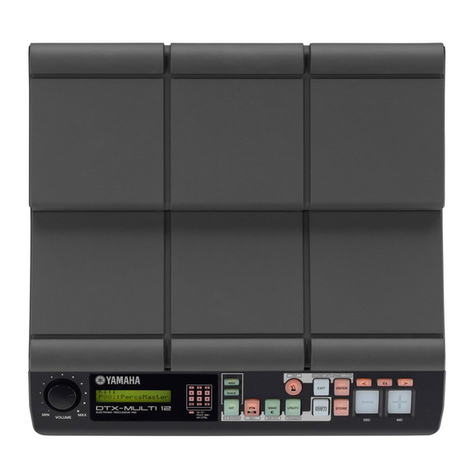Korg DW-8000 User manual

PROGRAMMABLE
DIGITAL WAVEFORM
SYNTHESIZER
OWNER'S
MANUAL
KORG

FEATURES
OF
THE
KORG
DW-8000
1
A newkind of 8-voice programmable
polyphonic synthesizer featuring an
advanced Digital Waveform Genera-
tor System (DWGS).
The DWGShas sixteen digitally encoded
waveformsstored in four 256 kilobit ROM
chips. These waveforms are digitally en-
coded samples of actual acoustic instru•
ments recreated by additive synthesis
techniques
to
enable more realistic
sound synthesis. (Thesixteenwaveforms
also include simple sawtooth and pulse
waveforms such as
"~,
n
..
" and "I\J"
which are found in conventional analog
synthesizers.)
2
Uses
two
Digital Oscillators, analog
noise generator, and VCF and VCA
modules for sound synthesis. You
can
enjoy
the
uniqueness
ofdigital
sound
plus quick and logical sound synthesis
as
in analog -control.
3
The DW-8000 features a keyboard
with Initial Touch (key velocity) and
After Touch (channel pressure) func-
tions. These functions give you real-time
control
at
your fingertips of output
volume, tone color, and pitch modulation
for finely-controlled, dynamic playing.
..
,

Thank
you
and
congratulations
on
your
choice
of
the
Korg
DW-8000.
To
obtain optimum performance
from this advanced digital synthesizer? please
read
this
manual
carefully before using this synthesizer.
4
A programmable digital delay is in-
cluded to store clear stereo effects
(Chorus, Doubling, Short Delay, and
long
Delay) for each of
64
tone colors in
the programmer.
5
Built-in Arpeggiator with MIDI control
capabilities and Assign mode, which
can function as 64-note sequencer.
6
Auto Bend is included for more real-
istic synthesis of human voice and
brass sounds.
7
Polyphonic Portamento can
be
con-
trolled by footswitch.
8
Key Assign mode provides two poly-
phonic modes and two unison
modes, which are effective for play-
ing solo
or
bassparts or using Portamen-
to.
9
MIDI equipped for full interfacing with
other MIDI equipped devices, includ-
ing synthesizers, sequencers, and
personal computers.

IMPORTANT
SAFETY
PRECAUTIONS
■
LO CATION
To avoid malfunction do not usethis un.it in the followi
ng
locationsfor long
periods of time:
•
In
direct sunlight.
• Exposed
to
extremes of temperature or humidity.
•
In
sandy or dusty places.
■ POWER
SUPPLY
• Use
on
ly with rated
AC
voltage. If you will be using this unit in a country
having a different voltage. be sure
to
obtain the proper transformer
to
convert to rated voltage.
• To
he
lp
prevent noise and degraded sound quality, avoid using t
he
sameoutlet asotherequipmentorbranchingoffextension cordsshared
by other equipment.
■
INPUT/OUTPUT
JACKS AND CONNECTION CORDS
Be sure to
us
e standard "guitar" cables with phone plugs, such as
the
cable suppliedwith this instrument, for input and outputconnectionsto
the
rear panel of the DW-8000. Never insert any other kind of plug into these
jacks.
■
PREVENTING
ELECTRICAL INTERFERENCE
As a microprocessor based device,
the
DW-8000
is
extremely flexible 1in
operation, yet may possibly perform erratically
if
exposed
to
electrical in-
terferencefrom otherelectrical devices and lluoresoentlamps. Avoid oper-
ating the DW-8000 near possible sources of interference.
If
somethi
ng
seems to be wrong, try turning off
th
e power, waiting about ten seconds,
then !urni
ng
it back on. This resets the computer circuits to their initial
state so performance should return to
no
rmal.
■
HANDLE
GENTLY
Knobsand switchesare designed to provide positiveoperationwith a li
ght
touch.
Excessive
force
may
cause
damage.
■
MAINTENANCE
Wipe the exterior with a soft,
dry
cloth. Never use paint thinner, benzene
or other solvents.
■
KEEP
THIS MANUAL
Store this manual in a safe place for future reference.
■
MEM
ORY
BACKUP
•To
protect your programmed memo
ry
contents, the
DW
-8000 utilizes a
built-in rechargeable backup battery power supply. Battery li
fe
is rated
at
live
years
or
more,
so
replacement
is
recom
mend
ed
after
five
years
,
Contact your Karg dealer or authori2ed service center at that time.
•
For
maximum securi
ty
, save your sound p
rog
rams on tape, using
the
bu
il
t-in tape interfacesystem. Then ii memorycontents are accidentally
erased oraltered,youcan simplyloadthedataback into DW-8000 inter-
nal
memory in seconds!

CONTENTS
FEATURES
&
FUNCTIONS
6
1
FRONT
PANEL
6
2
REAR
PANEL
and
BASIC
SETUP
8
SELECTING
PROGRAMS
This
e~pla
ir1s
how
to
se,ect
any
of
the
sounds
stom! in
the
0W-80(!0's
memor
y,
10
1
About
Program
Numbers
10
2
How
to
Select
a
Program
Number
10
CREATING
SOUNDS
How
,o
make
new
sounds
12
1
Sound
Synthesis
Techniques
12
2
How
to
Make
New
Sounds
13
3
Parameters
Stored
in
Memory
15
4
Writing
Programs
to
Memory
33
PERFORMANCE
FEATURES
How
to
p!ay
effectively
36
1
Functions
for
Playing
36
2
How
to
Use
the
Arpeggiator
40
TAPE
INTERFACE
43
1
Features
and
Functions
for
Control
43
2
Saving
1
Program
Data
on
Tape
44
3
VERIFY
Procedure
46
4
LOAD
Procedure
48
5
Tape
Interface
Precautions
so
MIDI
51
1
How
MIDI
Works
51
2
DW-8000
MIDI
Features
55
MIDI
IMPLEMENTATION
60
1
Transmitted
Data
60
2
Recognized
Receive
Data
63
3
System
Exclusive
Message
Reference
66
SPECIFICATIONS
AND
OPTIONS
73

FEATURES
&
FUNCTIONS
1.
FRONT
PANEL
_____
--!'
■
JOYSTICK
-----~
■
ARPEGGIATOR
-
---
--
---
-
--
SPEED, ASSIGNABLE, OCTAVE, ON/OFF,
LATCH
, SPEED INDICATOR, OCTAVE INDICATOR
■
KEY
ASSIGN
--
POLY 1,POLY 2,UNISON 1,UNIS
ON
2
■
EDIT
SLIDER - -
■
PROGRAM
SWITCH -
■
PARAMETER
SWITCH
----------------------
--
-
■
NUMBER
SELECT BUTTONS
---
1 - 8 (1: SAVE, 2: LOAD,
3:
VERIFY, 4; CANCEL)
■
PARAMETER
LIST - -
-----------------

FEATURES
&
FUNCTIONS
-----
---
--
--
---
-------
--
-■
VOLUME
--------------
-
■
TUNE
--
------
--
■
VALUE
UP.DOWN
--------
■
INDICATORS
PROGRAM
NO
,,
PARAMETER NO,,
VA
L
UE
--
■
PROGRAM
WAITE
KEY
-
------
■
BANK
HOLD SWITCH
,--------
-
-
■
OSC
ILLATOR
WAVEFORM
111111111111111111111111
111111111111111111111111111111111111
7

FEATURES
&
FUNCTIONS
2.
REAR
PANEL
AND
BASIC
SETUP
__
■
TAPE
SWITCH
■
WRITE
SWITCH1
--------------------------------
■
MIDI
TERMlNALS
----------
--
----
--
----
I
N,
OUT, TH
AU
■
AC
CORO RECEPTACLE
■
POWER
SWITCH
11111
~
111111111~11111111111111111111111111111111111
~
111111111
,
r1
,.,
.
.,
" " "
~
CAU
YoON
,
.,..,_,
.,
w.•><w
m,
,.
~.
""
"
KORI
.
~
-.
,
,..
)
~
t)(1..Ci<
11.•
~,-
-,:c:;"'-'
~ \
"il:.O
.-
r,e
f!'
,C:
t.,,.f.U.
IOAA
>$,
"1-._
"'
!pl
-
--.
. •
..
..-.
r
rn
su,.,.:,.,,;,
rQ
:)li<1JF.,_,1M
.,•1C
r.>'r.n
_
._
I
!J
(
~
0
l)
\~)
~:~
:-
$
AVIS
"-t'
~(l>Ot
l\ t~:
U•
~
J>~
•
c.
~00
,,0
11.
""'7-;
..
~~:!,
,.-
WI\AHING
f
l)~U
,¥;
( >;<t.
N~
V ••t
<.,t>
l
U<:t...-
.
E3
,---.
,.,..
,,.
......,
:!
'll
~(~~Y;"
>l>{l.;
(n,,oj
o>
IOi
)()l.ll.,r
1(
,,._~
N<>
lir
s
o>1
:
\
Ing
is
pro-
After
everyth
peny
connect
power on. ed,
turn
the
W{
.
't
No sound
is
ger>erated
for
about
one
second
after
thepower
Is
switchedON.
Theidlspla:y
show1f.•a
a
Va"
during ttne one-aecond
period.
1
111111
'
r,
'.in
1111111111111111111111111111111111111111111
LJ
Accessory AC
cord
Set
the
WRITE
switch
lo
DISABLE.
WAITE
'CI:D.
'
ENABl.£
DISA8~£
'.
I I ;
,r
' ...,
om
~
Plug
It
into a
well soeket
L.
.W
--
-
-
~
;
Set
the
TAPE switch
to
DISABLE.
TAPE
ENABLE
D!SA8L.E
, r
Liffl
'
II
set
to
ENABLE, no
110und
will
be
produced.

i
FEATURES
&
FUNCTIONS
.--
--
--
-
----
--
■
FROM
TAPE
L
OW
/HI
GH
SW
ITCH
-
■
TO
TAPE
r-
------
---
■
PROGRAM
UP
r---
---
--
■
PORTAMENTO
,-----
--
- ■
DAMPER
r------
■
PHONES
---
■
OUTPUT
HIGH/LOW
$W
IT
CH
LEFT
/MONO
RIG
HT
-------------..---
....
•
~-
1
~~
f
~/
LI
J
Plug
ste,.o
headphone,
If
used,
into
thisjack.
KH-1000,
ete.
(@
KIHOOOetc.
,.
L
Use
these
jacks to eonnect ampliflers.,
mixers,
or
stereo systems.
rr===c:))
!11-75
,
fll-lll
,ete.
Stereo system
If
the
two
outputterminals are eonnecl•
ed
to independent amplifiers,
stereo
ef-
fects
can be produced.
Use
only LEFT/MONO
lor
eonn;eclion
to
a
single
ampHfltr
of mixer
channel.
Set the
LOW/HIGH
switch
as
follows accord-
ing to the connected ampmier type.
Amplifier
and
lnput-tenninal \
l1J)ell ! Switch position
--
-
----
-·-
i--
·-
---
---
-
Audio
amp
(AUX IN)
Guitar
amp
(INPUT)
Keyboard
am1>
(INl>UT)
Mixing console (AUX,
INPUT)
HIGH
LOW
HIGH
or
LOW
HIGH
or
LOW
9

SELECTING
PROGRAMS
Thili
explainli
how
to
1,elect
any
of
title
64
different
1,ound1>
1,tored
in
the
OW-8000's
memory,
The
PROGRAMMER
section
on
the
front panel
is
used for this purpose.
1.
About
Program
Numbers.
___
_
The DW-8000 can be store
up
to
64
different sound pro-
grams in its internal memory. Each of these programs
has a numberfrom
11
through 88(thedigitsOand 9 are
not used). When you want to store a sound, you must
assign
it
a program number. When you want to recall
that sound, you select
it
by t
he
same program number.
Every sound
gels
a program numbe,r.
,--
-·
-·
....
··-····
·~
--
··
..·--
...
,..
____
!'
.\'
!11Jn!)
OfO!)l'a,mtl
........
__
,.
------
....
, Sound progtam
me-mo,l'y
(64
tota.l)
: l 1,...,l8 (
ll
l
•
I
:
21
-
28
(11)
I
: 3
l--
38
Ul
I
: 4
).-....
48
Ut
I
p t
-5
8
CO)
•
I
61
- 68(
8)
•
•
:
7'
......
78
i i }
•
~
s
1,
...
,sa
c
11
>
_____
_,
-------
-------
-------
•••••••
--------
•••••••
-------
•••••••
You select the program number of the sound that
you want
to
play
or
edit.
2.How
to
Select
a
Program
Number_
0
Features
and
Functions
for
Control
I• PROGRAM switch
When this switch isactivated(and its
L.ED
indicator
is
on)
, different programs may be selected using the
NUMBER keys.
2.
NUMBER keys
Press these keys to specifyprogram numbers, which
range from
11
through
88.
Programs are arranged in
eight "banks," signifi
ed
by the left digit, wi
th
eight
programs per bank, signified
by
the ri
ght
digit; 8 x 8
,
r.
64 total programs.
3.BANK
HOLD switch
This holds the left "bank" digit
so
that you can use
single nurnber keys
to
quickly accessany
of
the eight
program nurnbers within a single bank.
4.
PROGRAM NO. display
Shows selected program number.
10
,·
,.
wr
A=i
Jtl5f1[~
¥,J::tJ1
~
I t-11
11,
V.~ l
(W
> >
l<ro'
-j
""irlrz:m:rJ
•..
I I
41

~
How
to
Select a Program Number
1 Ma
ke
sure the PROGRAM switch
is
set to ON. (LED
is lit.)
2 Pressthe NUMBER keys to select any
pro
gram num-
ber
(11 -
88).
~
How
to
Select
Bank
Hold
LL
Pressing the BANK HOLD switch preserves the left
digit
of
the selected program number.
@I
Now
if you press any of the NUMBER keys, only the
right digit will change.
~
When you want to change to
a.
program number in a
differentbank, press the BANK HOLDswitch again
to
cancel BANK HOLD. You can now enter both digits
using the NUMBER keys..
SELECTING
PROGRAMS
r
9,
--
---L
ED
is
ON
.
Example: To select program number...
2
Press g
Press g •
PROGRAM
NO
PROGRAM
NO
•
PROGRAM
NO.
,,
A
dash
appears
in
tlle
right
hand
digit
u
ntil
you
se
lect
the
second
dig
t (Th
is
means
it
is
waning
fo
r
you
10
se
l
oct
tlle
seco
nd
digi
t.)
lfllr
LE
D
dot
li
ghts.
PllOGRAM
NO
An
LED
do
tl
ights
up
to
ind
i·
care
Ih
a!
the
bank
n
um
ber
(2)
will
no
t
change
.
On
ly
tllis
dign
chan
ges
wllen
__
_ _ /izik
you
pr
ess
the
number
keys
.
Ealll
BAIIK
HOLD
Nowpress
~
PROGRAM
NO
.
•
PROGRAM
NO
PROGRAM
NO
Th
e
LEO
dot
goe
s
out
when
BANK
HOLD
is
off.
11

CREATING
SOUNDS
How to Make New Sounds
1.sound
Synthesis
Techniques
__
_
D Parameters and Values
Thevariousaspectsofa sound, such
as
itspitch, tim-
bre and variations in volume, are called "Parame-
ters." To create or change a sound, yo
u,
adjust the
vaiues
oi
each of these parameters.
On the DW-8000, there are 49 parameters per pro-
gram; each parameter has a number, and each pa-
rameter's value is also represented by a number.
These numbersareshownon the front panel display.
To create or change a sound, you select parameters
and change (or "Edit") their values.
Parameters
lor
oscillator
1
OSC1
11
OCTAVE
16'
8'
4'
When the DW-8000 stores a sound in memory
or
calls it
back
from memory,
it
is
actually storing and
recalling the values you have given it for
the
sound's
various parameters.
All
possible parameters and
values are listed in the "parameter
index"
chart
on
the rightside
of
the DW-8000 frontpanel. ii"ocreate or
change a sound, you first usethe number keys
to
se-
lect a parameter number, then you use
the
editslider
and up/down keys to change its value.
WAVEFORM)
1
◄
•16
f',J
Sound Synthesis on
the
DW-8000
'
13
LE
t
EL
Parameter
number
12
WAVEFORM
!
0
◄
\
►
31
!
i
VaJue
range
:
1 -
16
To create new sounds on the OW-8000, you change
or edit old programs. You do not start with a "blank
slate", There are 64 sounds already in memory. If
you have a new sound in mind, the easiest approach
is
to first selecta sound thatresembles
the
soundyou
want
to
create. Then
"edit"
(change
the
selected
sound until you get the sound you want. If you don't
find a similar sound, it doesn't matter; start with any
sound you iike.)
After you finish editing your sound, you s!ore
it
in!o
memory. At
this
point you can give it a different pro-
gram number (thereby preserving the sound you
startedwith)
or
thesame program(therebyerasing
or
"overwriting" the old sound).
Selecting a
Program:
Anding
a cur-
rent
program-
med
sound
that
resembles the
new
one
you
wish
to
create.
Creating
Sounds (Editing):
Changing the
values
of
the
parameters that
need
to
be
changed
to
ob-
tain
the
desired
SOOl1d.
Writing
the
Program
to
Memory:
Giving the
S01Jnd
a pro-
gram
number
and storing it
in
memory.

CREATING
SOUNDS
2.
How
to
Make
New
Sounds
__
_
D
Features
and
Functions
1or
Control
iRfAESttES
I
KEY
ASSIGN SECTION
VALUE
OOWN
UP
I~
I
L.. I
i
3/4
Used
to select assign mode :suited for the created
sound. (See
"KEY
ASSIGN" on page32.)
2
EDIT
SLIDER
Permits rapid and easy adjustment of parameter
VALUES (aspects of the sound) over a wide range.
3/4 DOWN/UP keys
Press to change parameter values up
or
down a step
at a.time.
S PARAMETER swrtch
When
th
is switch is on, you
can
create and modify
sounds
by
selecting different parameters (using the
NUMBER
keys) and varying
their
VALUEs (using the
EDIT
slider and/or DOWN/UP buttons).
I!':)
How
to Change Values
LWith PROGRAM switch on,
use
the number keys to
sele,ct programs
and
play the keyboard to lind
out
what they sound like. Stop
when
you find
one
thatre-
sembles the new sound that you want
lo
create.
I
,;
Press the PARAMETER
switcn
so that its LED lights
up.
• JI.
r--
J
1bbfJ-d
PROGRAMPAA.IMEleRl'
1 2 3 4
rhf-JJd;
59.
m
"'-f""
""""
•••
*• .
j:j;
6
6 NUMBER keys
•
\'AlUE
i
7
These keys are used to select different Parameter
Nury,bers (when the parameter switch is on).
7 BANK HOLD switch
Th
is
holds the Parameter Number's left digit, so that
the NUMBER keys
can
be used to select only the
right
digit.
This
can
speed
up
Parameter
Number
se•
lection when you are working on several parameters
within thesame "family" (that
is
,having thesame left
digit).
8 PARAMETER NUMBER display
Shows selected parameter number.
9 VALUE display
Shows current VALUE for selected parameter.
PAAAM~TER
~--
-
·····LEO
is
on
13

CREATING
SOUNDS
@I
Refer
to
theparameterindexchart to fi
nd
the number
of the parameter that you want to change. Press the
number keys
to
select the desired parameter.
When the BANK HOLD switch is pressed, the left
digit
is
locked; then, you can change
the
right digit
by
using the NUMBER keys.
~
Use the Editsiideror Up/Downbuttons tochangethe
parameter's value. Suggestion: Use
the
Edit slider to
make large changes in value, then use the Up/Down
keys
to
"fine tune" the sound. (VALUE display)
The
LED
dot in the corner
of
the VALUE display indi-
cates that the val
ue
of
thecurrentlyselected parame-
ter has been changed. The dot goes
out
if
you
return
to
its original value.
Ifyou want to return to the original valueofa parame-
ter, just pressboth UP/DOWN keys at thesametime.
~
Repeat steps 3 and 4 foreach parameter that neeas
to
be
changed.
14
lo
store your new soundsin memo
ry
, follow the oper•
ation procedures described ir, "WRITING PAO•
GRAMS TO MEMORY" on page 33.
Example;
Se!
ectiog
VCF
CUTOFF
rr
e
,iuen
cy
. ...Th
is
is
parame
ter
num-
be
r
31
,
so
...
3
--
·
······
--
··A
da
si
1
in
me
ri9ht
han
ddigit in(tcates
Press
■
-
■
1111~
,~;;;~.
1
ha
1diSw11it
in
gf
or
1
Pressg
UPt==t
--~·-
~•
ou
r,l
e:x
t
in
rJvl.
■
W·V•
1
•:
:111:w-
•
••
' ,1
~-
•
VALUE
DOWN UP
~
VALUE
tEO
dOi
f;
gJu
s.
DOWN UP
f>ress~
sL0
1u
ilaoeous
1y.
.....

CREATING
SOUNDS
l.
Parameters
Stored
in
Memory
__
This
section
describes
parameters
which
can
be
stored
in
the
DW-8000
's
memory
to
create
your
sounds.
0 OSC1
12
WAVEFORM
1
◄ ►
16
13
LEVEL
0
◄
► 31
.OCTAVE
Here
you select
the
basic pi
tch
range
of
oscillator 1.
The
higher
the
value, the
lower
the
pitch. Y
ou
have
three
choices which correspond
to
16 ' {16 foot). 8
',
4 ' .
.WAVEFORM
The
cho
i
ce
of
wav
eform will h
ave
more
effect on the
I
OM
I
cha
r
ac
ter
istics (t
imb
re
or
tone
color)
of
the
sound
than will
any
ot
her
parameter.
You
have sixt(,en basic
waveforms
to
choose from.
VALUE
WAVEFORM
'
I
2
,
C
-a
-;
=,
-4
Parameters
In
this module determine the
basic pitch
range
(OCT
AVE)
and timbre
(WAVEFORM).
VALUE
5
:s
8
L'
'
,-
=,
6
OCTAVE
16
' {low)
8'
{middle)
4 ' (high)
-
7-
-;
I
8
,-,
c,
INSTRUMENT Br
ass,
st
rings,
FAMILY
Ctat
in
et
.and
ana
•
Aco
u
sti
cpi
ano
E!ecu
ic
pian
o
E!
ecu
ie p
r.mo
Cta
\'i
O,ya
n H
rass
a
nd
iilla
iog
S\'f1-
to
gs
w1
tr:esiz
ers
l
he
Sii:
ers
(ll
a1mon
ic:s
tom
•
PQ
!t
a:n
ts a
,e
the
sa
m&w
!'th
"rt:
'}
1,
I
,,
VALUE
=,
I
LI
WAVEFORM
9
INSTR
UM
ENT
S~•
O
Ph
O<l
~ Viol
in
FAMILY
(Mrd)
' ,
,,
,,
I I I
l-
I
=I
--
--
Acooslic
g
utta
, O
on
a,
(d
ist
orte
d)
f
lec
tr
ic
b;l;s
,'-'
I '
14
O
il1i
t1.
,t
ms
I
,-
I :,
Bal
l
,
,-
I
C,
Or
ga
nand\
·,
11:
s.
Ile
15

CREATING
SOUNDS
.LEVEL
Sets out
pu
t level (volume) of oscillator 1.
Th
is is useful
for adjusting overall volume
to
match other programs,
and for
ba
lancing OSC1 with OSC2
and/o
r
no
i
se
as de-
s
ir
ed.
fJAUTO
BEND
AU
O
BEND
CJ!'
OIC1
09::1
lllTH
14 SELECT O 1 2 3
--
"'-
15 MODE 1 2
16
TIME 0
◄ ►
31
17
INTENSITY 0
◄ ►
31
.SELECT
Selects the oscillator(
s)
for AUTO BEND.
.MODE
Se
lects b
et
ween UP and DOWN modes. In UP mode,
the pitch rises to the pitch
of
the pressed key. In DOWN
mode, the pitch fa
ll
s to the pitch of the pressed key.
_,&
VALUE
n
u
l
3 :
OUTPUT LEVEL
No
sound from
OSC1 l
Maximum
vo
lume
This parameter adjusts the change in pitch
produced when a note
is
played
on
the
key-
board.
As
soon as a key
is
pressed, the pitch
is
shifted to the pitch level ofthe pressed key.
This is useful for the synthesis of human
voice and brass sounds.
VALUE
,...,
..,
..,
C
VALUE
'
'
z
Oscillator Used for AUTO BEND
No oscillator (AUTO BEND OFF)
OSC1
OSC2
OSC1 and OSC2
Pitch ChangeafterKey Pressing;
Pit.ch rises to the key level
Pitch falls to the key level
7
_I -

Pitch
P
ressed
key
pitch
Pitch
change
Key
pressing
.TIME
DOWN
mode
,
UP
mO<!e
Time
Sets a period
of
time
from
th
e k&y pressing
to
the
time
when
the
pitch reaches the pitch
of
the
pressed key.
Pitch
Pressed
key
pitch
Pitch
change
Key
press
ing
.INTENS
ITY
Penod
set
by
TIME
Ti
me
Specifi
es
the
pitch where pitch
change
starts.
Pilc
h
Pressed
key
pitcll
Pitch
change
Key
pressing
Pilch
in
t
erva
l
set
by
INTE~ISITY
Pilch
fiterval
set
by
INTEN
SIT
Y
Trme
VALUE
n
u
1
:)
I
_,
'
VALUE
n
u
1
-,
I
j I
CREATING
SOUNDS
Ti
me
Period from Key Pressing
to the Pitch
's
Reaching the Key
Level
Shor
t
l
Long
Pitch Cha
ng
e Width
No
pitch change
(AUTO
BEND
OFF)
1
Max. bend width
17

CREATING
SOUNDS
(i30SC2
22
WAVEFORM
1
◄ ►
16
23
LEVEL
O•
►
31
24
IN
TERVAL
1- 3 3 4 5
25
DETUNE
0
◄
►
6
-OCTAVE
As
with OSC
1,
you have a choice
of
three pitch ranges:
4',
8'
,and
16'
.
• WAVEFORM
Once again, you have s
ix
teen wavefor
ms
to choose
from.
-LEVEL
Adjusts output level as in
OSC1
-INTERVAL
This lets you transpose or offset the pitch of OSC2 so
that it soun,ds a constant interval above
OSC
1. Select-
ab
le interv
al
s are: Unison(sameasOSC1), a minor3rd,
major 3rd,
per
f
ec
t 4th, or perfect 5th above.
-18
This
is
yoursecond sound source, designed
to be used together with OSC1 to
c:reate
thicker, richer and more complex sounds.
VALUE
IN
TE
RV
AL
' Unison
,
-,
-:,
Minor 3rd
3 Major 3rd
~·
, Perfect 4th
5 Perfect 5th
•You will get
di
fferent intervals (from those shown
above) depen,ding on t
he
OCTAVE
va
lues for the two
oscillato
rs.

-DETUNE
For fine pitch adjustment
of
OSC2 relative to OSC1. The
higher the value, the greater
the
pitch difference
be-
tween the two oscillators. Detuning can help achieve a
fatter, more animated sound.
~NOlSE
NOISE
26
LEVEL
-LEVEL
Adjusts noise volume.
lf]VCF
o
◄
►
31
o
◄ ►
63
32
RESONANCE O
◄
►
31
33
KBD
TRACK
0
1/4
1/
2 1
0 1 2 3
34
POLARITY 1 2
35
EG
INT 0
◄ ►
31
VALUE
n
u
l
5
CREATING
SOUNDS
PITCH DIFFERENCE
Minimum (no
detuning-same
pitch) l
Maximum
(25
cents)
Provides white noise
(a
mixture
of
all fre-
quencies) as a separate sound source.
This
is
useful
for
adding
"breath
noise"
to
simulated acoustic instrument sounds,
and
for
creating special effect sounds such
as
wind, surf, gunshot sounds, etc.
VALUE
,,
u
l
3 :
LEVEL
No noise
l
Maximum
This DW-8000s
eight
voltage controlled
fi
1-
ters (one per voice) remove
or
emphasize
portions
of
the basic waveform harmonics.
This affects
the
timbre
of
the
OSC1
, OSC2,
and
NOISE
waveforms. These VCF are
low
-
pass filters, which remove frequencies
above the selected CUTOFF frequency
(while allowing
lower
frequencies
to
pass
through).
19

CREATING
SOUNDS
-CUTOFF
Th
is determines the cutoff frequency of the low-pass
filter. The higherthecutoff frequency, the lesseffect the
filters have on the basic waveforms (since more fre-
quencies are passed).
At the highest value, 63, all harmonics are passed. The
lower the value, the more harmonics are cutoff, so the
sound becomes progressive
ly
rounder
or
less bright.
-RESONANCE
Thisemphasizes theharmonicsnearthecutofffrequen-
cy, producing a characteristic peaky or bandpass type
of
sound.
The
higher the value, the higher the resonance peak
and the more obvious the effect. At
or
near the max-
im
um value
31,
the VCFs
go
into self-oscillation, pro-
duc
i
ng
apure
sine
wave,
which
can
be u
sed
as
an
add
i-
tional sound source for special effects. T
he
pitch
of
the
VCF tone
is
affectedbytheCutOff, KeyboardTrack,
EG
INT, and
MG
VC
F parameters.
-20
VALUE
n
u
1
TIMBRE
Dull
or
rounded
1
,-
-,
Oj
Bright, unchanged timbre
I
Freque
n
cies
lowe
r
lhan
cutoff
:
fr
equency
are
passed
. I
I
I
I
0
._
__
______
_.,
_
_,_
____
___
_
t
Frequency
Cutoff
freq
u
ency
--
------
Value
--------
---
0
VALUE
n
LI
1
3 t
63
EFFECT
None
1
Self-oscillation, very "peaky"
sound.
+ /""\
Value
,'
•l
...-
H
armon
ics
n
ea
r
cu
t
off
+/
--r,
'
frequency
are
boosted
.
__
_____
_,_,
I
I
I
I
I
I
I
I
1
t
Cutoff
fr
equency
Fr
e
que
ncy
Other manuals for DW-8000
3
Table of contents
Other Korg Synthesizer manuals

Korg
Korg VOLCA FM User manual
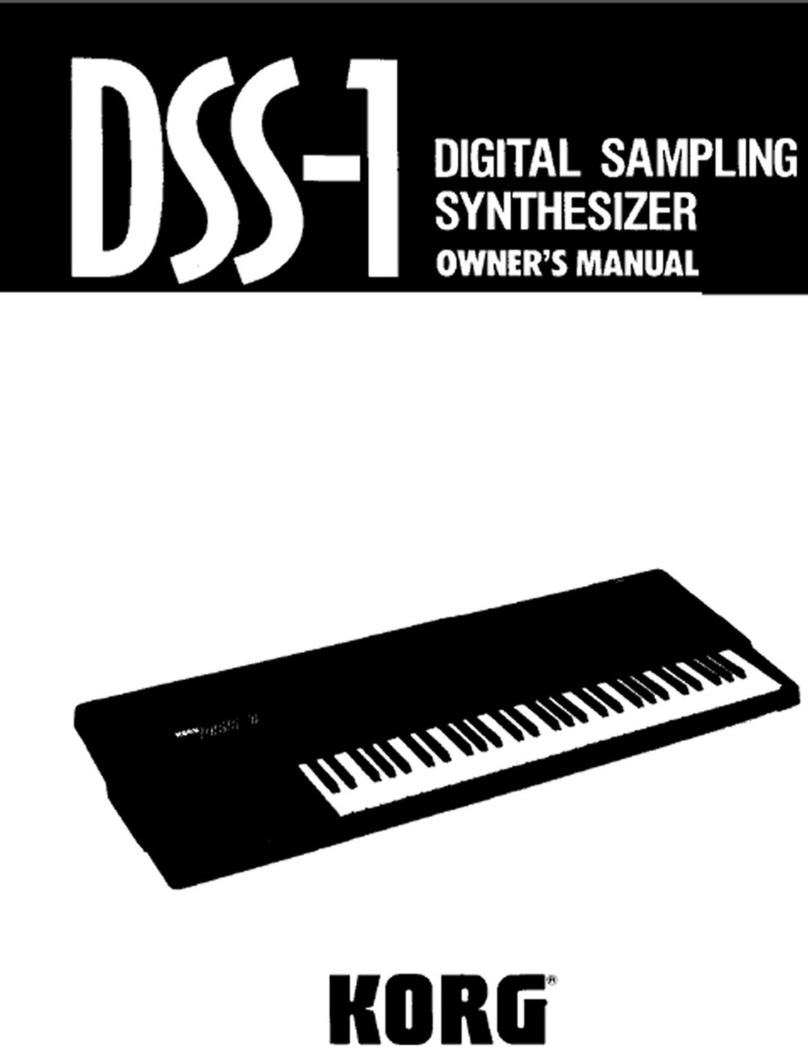
Korg
Korg DSS-1 User manual
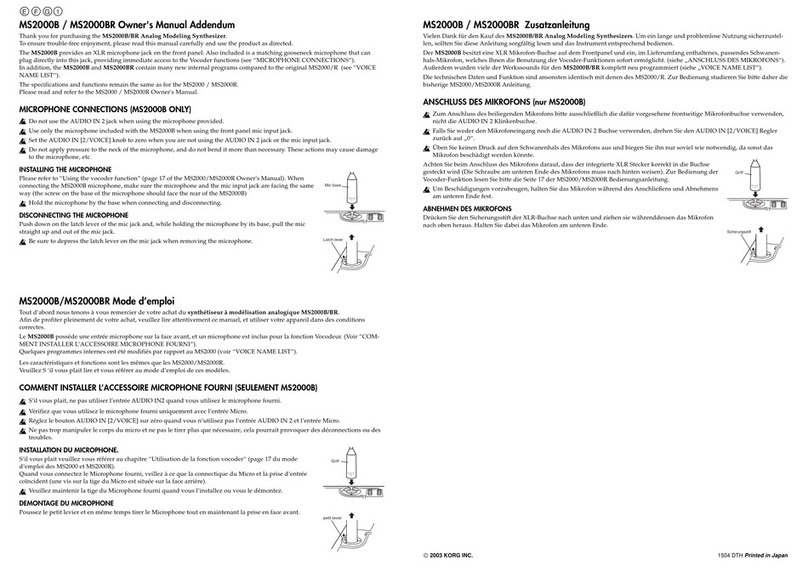
Korg
Korg MS2000BR Installation and operating instructions
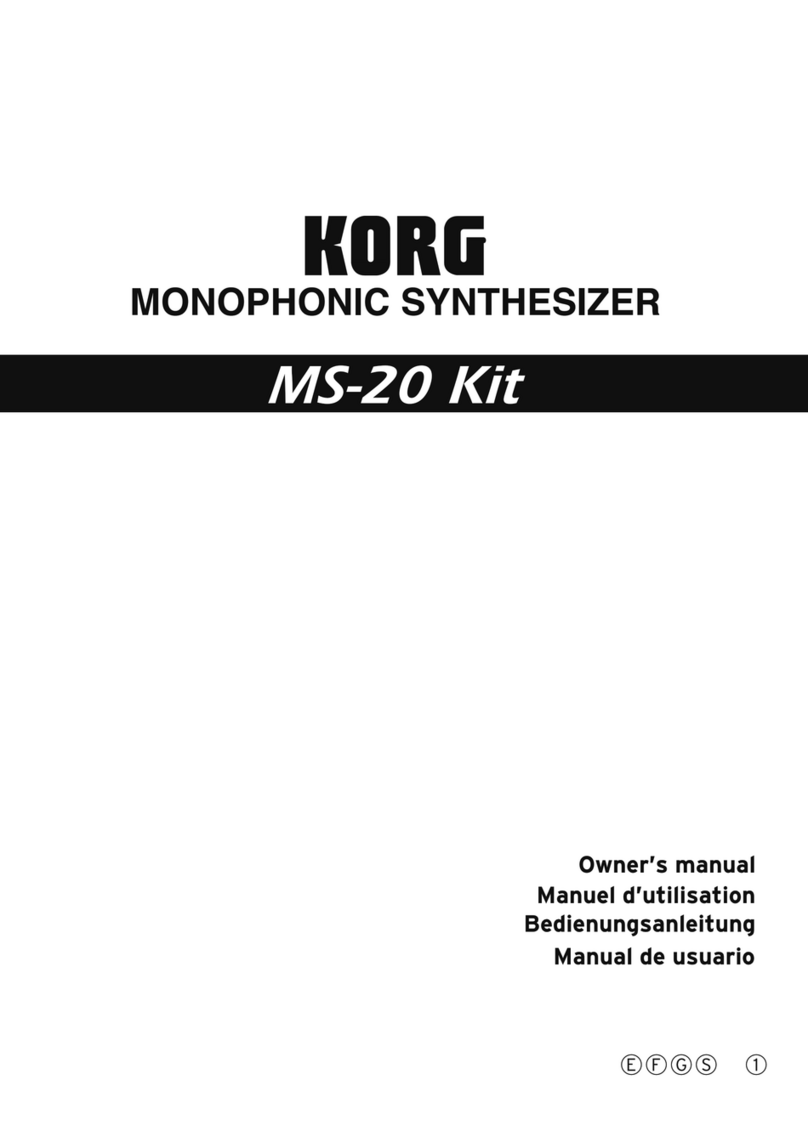
Korg
Korg MS-20 Kit User manual

Korg
Korg MONOLOGUE User manual
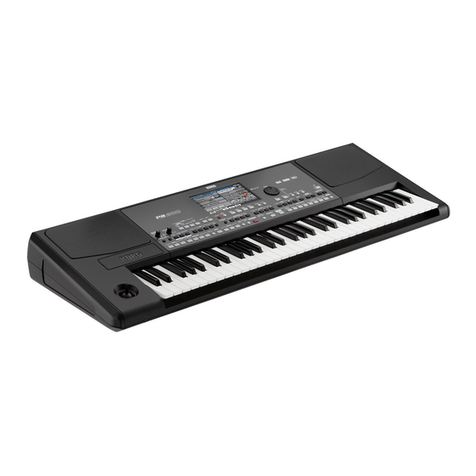
Korg
Korg PA 600 QT User manual

Korg
Korg PA 500 User manual
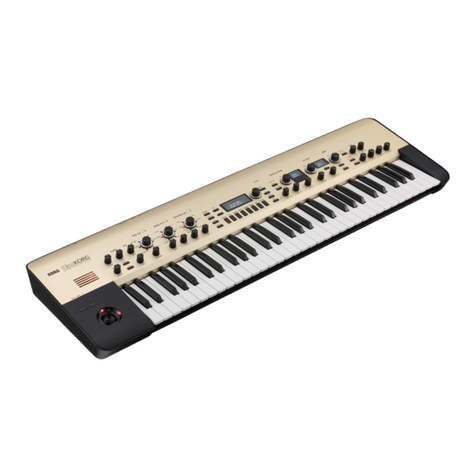
Korg
Korg King User manual
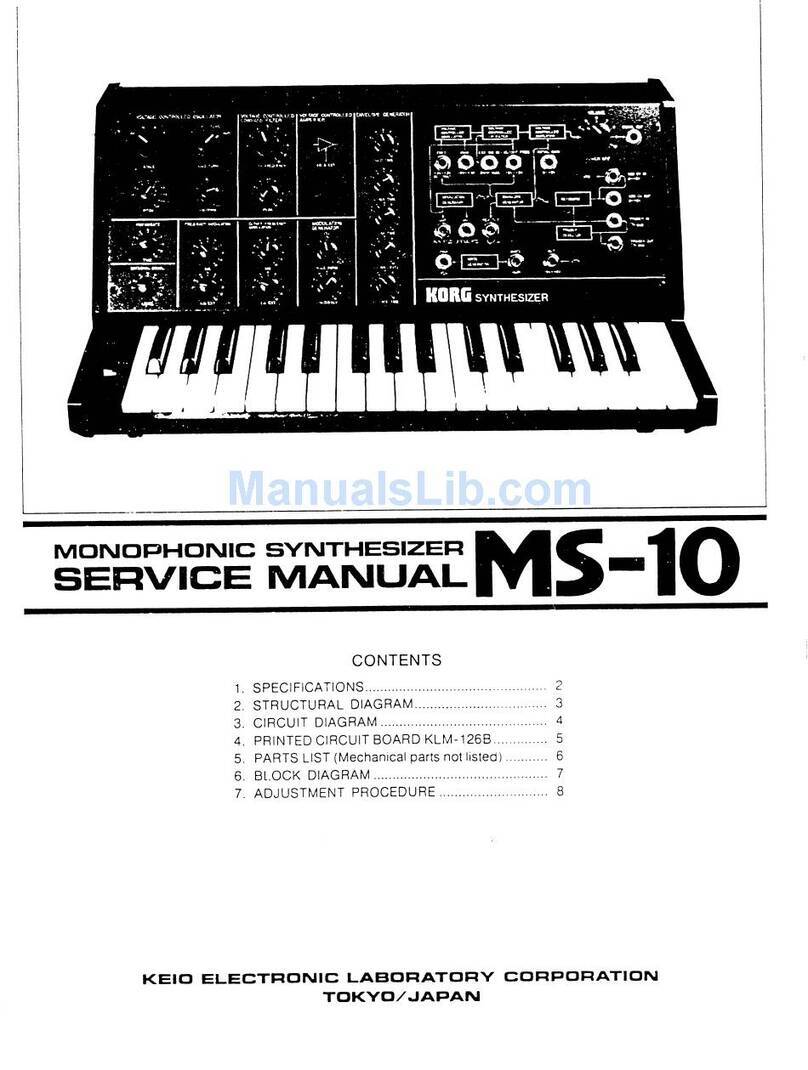
Korg
Korg MS-10 User manual
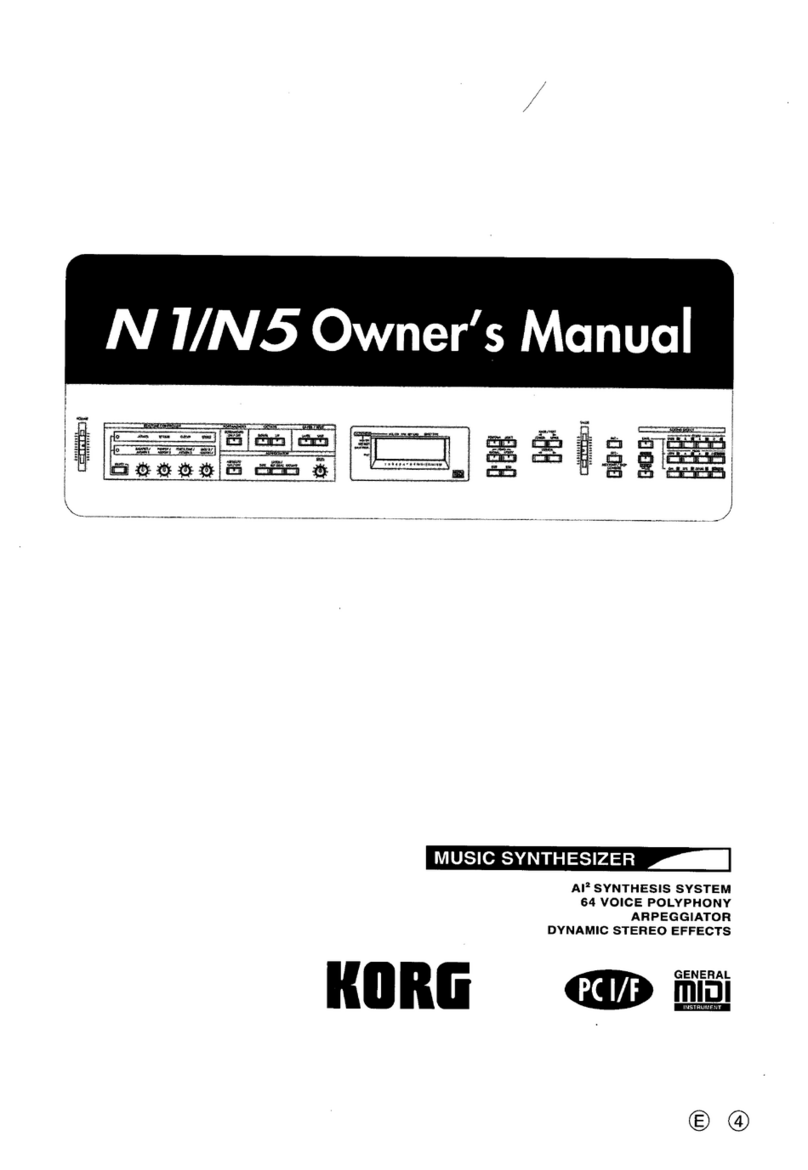
Korg
Korg N1 User manual
